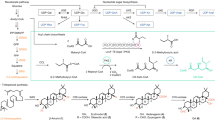Abstract
When foreign bodies, including many microorganisms, are ingested by cultured macrophages, they become enclosed in phagosomes, with which lysosomes usually fuse and then discharge their enzymes and other contents into the resulting phagolysosomes. Such fusion is, however, diminished or absent after the phagocytosis of some pathogens, notably Mycobacterium tuberculosis1 and Toxoplasma gondii2. Assuming that the nonfusion is due to active inhibition by the intraphagosomal microbe, identification of an inhibitor should clarify the lysosomal control mechanism. It has been suggested that strongly acidic sulphatides present in virulent tuberculosis, which, like other substances with polyanionic structural features, can themselves block phagosome–lysosome fusion (P-LF)3–5, may contribute to the negative lysosome response to ingested tubercle bacilli4. We report here another possibility, based on inhibition of fusion of yeast-containing phagosomes by filtrates from cultures of tubercle bacilli on traditional-type defined media; we show that the ammonia content of such filtrates is sufficient to account for their effect. This inhibition of fusion seems to be an hitherto unrecognized intracellular consequence of added ammonia, in striking contrast to the enhancement produced by some lipophilic amines3.
This is a preview of subscription content, access via your institution
Access options
Subscribe to this journal
Receive 51 print issues and online access
$199.00 per year
only $3.90 per issue
Buy this article
- Purchase on Springer Link
- Instant access to full article PDF
Prices may be subject to local taxes which are calculated during checkout
Similar content being viewed by others
References
Armstrong, J. A. & D'Arcy Hart, P. J. exp. Med. 134, 713–740 (1971).
Jones, T. C. & Hirsch, J. G. J. exp. Med. 136, 1173–1194 (1972).
D'Arcy Hart, P. & Young, M. R. Nature 256, 47–49 (1975); Expl Cell Res. 114, 486–490 (1978); Expl Cell Res. 118, 365‐375 (1979); in Mononuclear Phagocytes—Functional Aspects (ed. van Furth, R.) (Martinius Nijhoff, The Hague, in the press).
Goren, M. B., D'Arcy Hart, P., Young, M. R. & Armstrong, J. A. Proc. natn. Acad. Sci. U.S.A. 73, 2510–2514 (1976).
Geisow, M. J., Beaven, G. H., D'Arcy Hart, P. & Young, M. R. Expl Cell Res 126, 159–165 (1980).
Ratledge, C. & Hall, M. J. J. Bact. 108, 312–319 (1971).
Hanks, J. H. & Wallace, R. E. Proc. Soc. exp. Biol. Med. 71, 196–200 (1949).
Long, E. R. Chemistry and Chemotherapy of Tuberculosis 3rd edn, 80–85 (Baillière Tindall & Cox, London, 1958).
Ohkuma, S. & Poole, B. Proc. natn. Acad. Sci. U.S.A. 75, 3327–3331 (1978).
Seglen, O., Grinde, B. & Solheim, A. E. Eur. J. Biochem. 95, 215–225 (1979).
Reijngoud, D-J., Oud, P. S., Káš, J. & Tager, J. M. Biochim. biophys. Acta 448, 290–302 (1976).
Wibo, M. & Poole, B. J. Cell Biol. 63, 430–440 (1974).
Reijngoud, D-J. & Tager, J. M. FEBS Lett. 64, 231–235 (1976).
Goldstein, J. L., Brunschede, G. Y. & Brown, M. S. J. biol. Chem. 250, 7854–7862 (1975).
Author information
Authors and Affiliations
Rights and permissions
About this article
Cite this article
Gordon, A., D'Arcy Hart, P. & Young, M. Ammonia inhibits phagosome–lysosome fusion in macrophages. Nature 286, 79–80 (1980). https://doi.org/10.1038/286079a0
Received:
Accepted:
Issue Date:
DOI: https://doi.org/10.1038/286079a0
This article is cited by
-
RETRACTED ARTICLE: Ornithine-A urea cycle metabolite enhances autophagy and controls Mycobacterium tuberculosis infection
Nature Communications (2020)
-
The structure-based reaction mechanism of urease, a nickel dependent enzyme: tale of a long debate
JBIC Journal of Biological Inorganic Chemistry (2020)
-
Tuberculosis vaccine development: from classic to clinical candidates
European Journal of Clinical Microbiology & Infectious Diseases (2020)
-
Computational evaluation of glutamine synthetase as drug target against infectious diseases: molecular modeling, substrate-binding analysis, and molecular dynamics simulation studies
Medicinal Chemistry Research (2017)
-
The bacterial and host factors associated with extrapulmonary dissemination of Mycobacterium tuberculosis
Frontiers in Biology (2015)
Comments
By submitting a comment you agree to abide by our Terms and Community Guidelines. If you find something abusive or that does not comply with our terms or guidelines please flag it as inappropriate.



